WhatsApp is the premier OTT (Over-The-Top) messaging app for smartphones that is free to download and that is nearing surpassing the two billion users mark. It uses the internet to send messages, images, audio, or video, although the subscription to the service requires a verifiable mobile phone number. In its evolution, WhatsApp has expanded its offerings, opening different ways to communicate: WhatsApp, WhatsApp Business, and WhatsApp Business API.
Our implementation is the WhatsApp Business API, which has rules of usage that must be adhered to in order to enjoy its use. Although it represents a powerful tool for enterprises, medium and large, it comes with some pros and cons. Here is a brief summary,
- WhatsApp Business Account approval from Meta is required
- Template messaging must be approved by WhatsApp (response generally in 24 hours)
- Best for automation of processes via API.
- Mainly for central support and call centers at medium to large companies
- Used in automated systems.
- Does not have a real mobile interface
- It is not free, although some free messaging is available based on the reply patterns
- API can send messages through session and template messaging.
- No calling capabilities
- API broadcasts are not limited
The above gives you an overview of the scope of how WhatsApp Business API can be used for the purposes of your enterprise and in consequence, how to plan for it to take advantage of this messaging service. You can review WhatsApp Business Policy in detail by clicking here and WhatsApp Commerce Policy here.
Firing Up WhatsAppWhatsApp is a messaging channel that must be properly configured and enabled before it can be used.
To configure a WhatsApp Business Account (WABA) and assign phone numbers (senders), we offer two setup options: Partner-Initiated Request and Embedded Sign-Up.
The following table outlines the key differences between these two processes, including how each WABA is created and how phone numbers are managed:
Method
Description
Adding Phone Number Limitations
The WhatsApp Business Account (WABA) is created after the customer receives an invitation sent by the Messangi team via email or support ticket. The customer review and accept the invitation, optionally add a phone number (sender), and confirm. Once accepted, the WABA is created under the Meta Business account of the customer and shared with Messangi.
Phone numbers can be added and verified directly within the platform using the
feature, once the WABA is active.
Once your WABA is
verified
, you can add up to
25 phone numbers
.
This self-service method allows the customer to create or link their own WhatsApp Business Account (WABA) through the Embedded Sign-Up flow available in the platform. They must authenticate with Meta and complete the entire setup, including assigning a phone number and business profile information. The WABA is created under their Meta Business account.
Phone numbers must be added as part of the sign-up process. To add more numbers later, the client must repeat the Embedded Sign-Up flow.
During the WhatsApp Embedded Sign-Up process, you can add up to
2 phone numbers
(senders) while configuring your account if the WABA
is not yet verified
.
Once your WABA is
verified
, you can add up to
25 phone numbers
.
Please refer to the WhatsApp Status section for a detailed explanation of message status. The first section outlines the sequence of status values for outbound messages, while the second section details the three potential final statuses once a message is sent.
Sending a WhatsApp campaign or message
After selecting New Campaign, entering the Campaign Name, and selecting WhatsApp from the campaign options, you are brought to the WhatsApp campaign creation section, which has the following steps:

- Detail
- Recipients
- Message
- Summary
Detail
In the ‘Detail’ step,
-
In the Sender WhatsApp Business Account dropdown, choose from the list of available WhatsApp senders configured in your space. Each sender is listed by its alias and associated phone number.
Once a sender is selected, a summary panel titled WhatsApp Sender Information will automatically appear below the dropdown. This panel displays real-time information about the selected sender, including:

- Status: Indicates the current connectivity state of the sender with the platform. A status of CONNECTED means the sender is actively linked and can send and receive messages.
- Quality Rating: Reflects the performance level of the sender, based on user engagement and message quality as determined by Meta. A High rating suggests good message delivery performance and user experience.
- Tier: Displays the messaging tier level assigned to the sender, which determines the maximum number of business-initiated conversations allowed per day. For example, a Tier value of 1,000 allows up to 1,000 customer-initiated conversations daily using approved templates.
This ensures that you have selected a sender that is both active and compliant with Meta’s quality and messaging volume requirements.\
NOTEThe ability to proceed with a WhatsApp messaging campaign is contingent upon the operational status of the selected sender. If the sender is assigned any of the following statuses —
RESTRICTED,PENDING,DISCONNECTED,UNKNOWN,DELETED, orBANNED— it will be considered ineligible for campaign execution.Senders in these states are not authorized to dispatch WhatsApp messages or message templates, as they fail to meet the connectivity or compliance requirements established by Meta.
Consequently, the platform will prevent progression to subsequent configuration steps, such as selecting recipients or composing the message, until a sender with a valid status is selected.
For a detailed explanation of Tier levels, Quality Rating values, and Status definitions, please refer to the corresponding documentation section: WhatsApp Sender Quality Rating & Status.
- Select Next.
Recipients
As you begin using WhatsApp, your account will be set at a starting level designated as Tier 1. There are four Tiers, and each Tier allows you to send messages according to the following:
- Tier 1: to 1,000 unique customers in a rolling 24-hour period.
- Tier 2: to 10,000 unique customers in a rolling 24-hour period.
- Tier 3: to 100,000 unique customers in a rolling 24-hour period.
- Tier 4: to unlimited customers in a rolling 24-hour period.
NOTEWhatsApp tiers (also known as messaging limits) apply per phone number (sender), not per WABA.
Although a WABA (WhatsApp Business Account) can have multiple senders (verified phone numbers), each sender has its own independent tier, determined by its reputation and activity level.
In consequence, it is important that when you specify the subscribers, their numbers need to fall within the limits established by the Tier that your business is currently at. For further details click here.
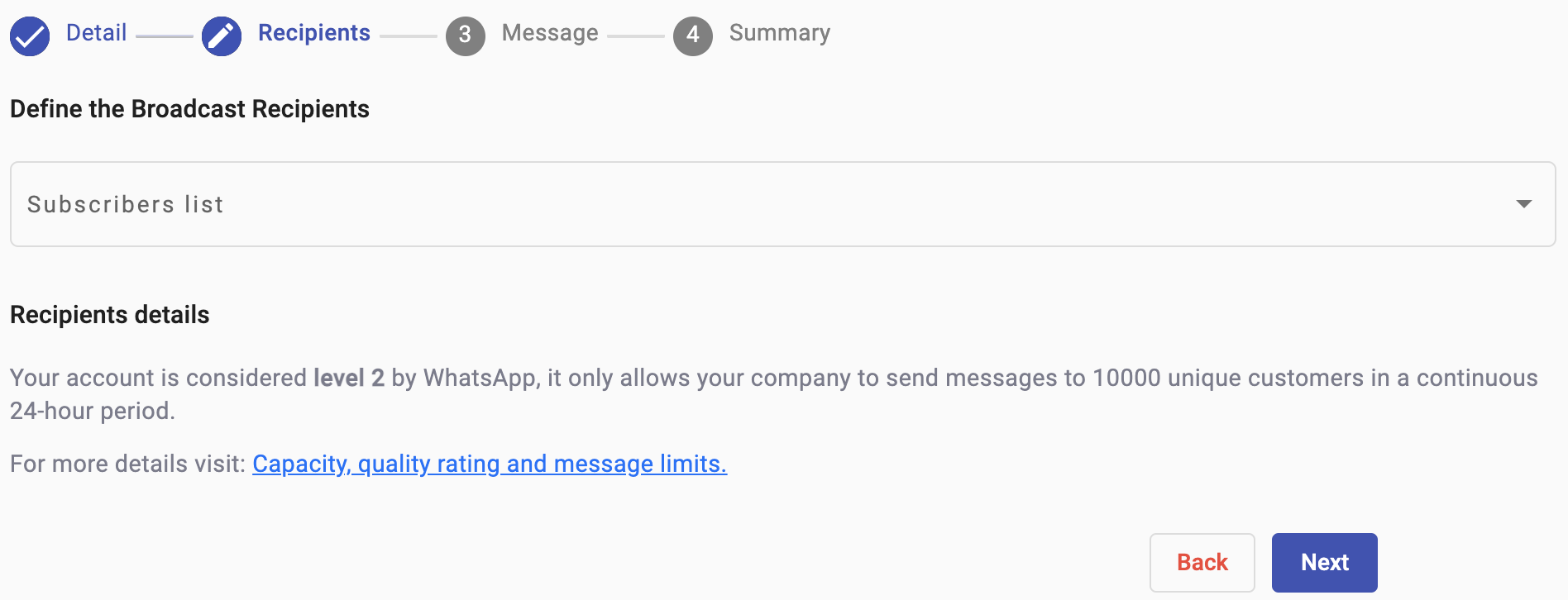
The Recipients can be defined in one of three ways,
For the case of WhatsApp, given that the engagement policies are very specific and impact your Tier level, you should choose carefully which one is best suited at any given time, as each of the methods of defining recipients serves a different need.
The details for defining the recipients are outlined in Define Recipients in the Campaign Elements section; nevertheless, here are the basic steps:
- In the Subscribers list dropdown menu, choose one of the options.
- Optionally apply a filter if the campaign requires it
- After selecting the Recipients, click Next to continue.
Message
The ’Message’ step in the process is context-dependent, and it will consistently vary between two scenarios throughout your use of the service.
There are two ways of creating a message for a WhatsApp campaign or message:
• Using a Template
• Without a Template
Using a Template
In the case that you are initiating contact with one of your customers, you must use a previously WhatsApp-approved template in the communication.
The templates that have been approved by WhatsApp for your enterprise appear at the top of the Message screen for ease in selection. You must use one of those templates.
In the sample screenshot that follows, there are two preapproved templates to select from. As you evolve in your use of WhatsApp with your enterprise, other templates can be included after the WhatsApp approval process. You can scroll to view all your templates with the left and right scroll arrows at each side of the templates section.
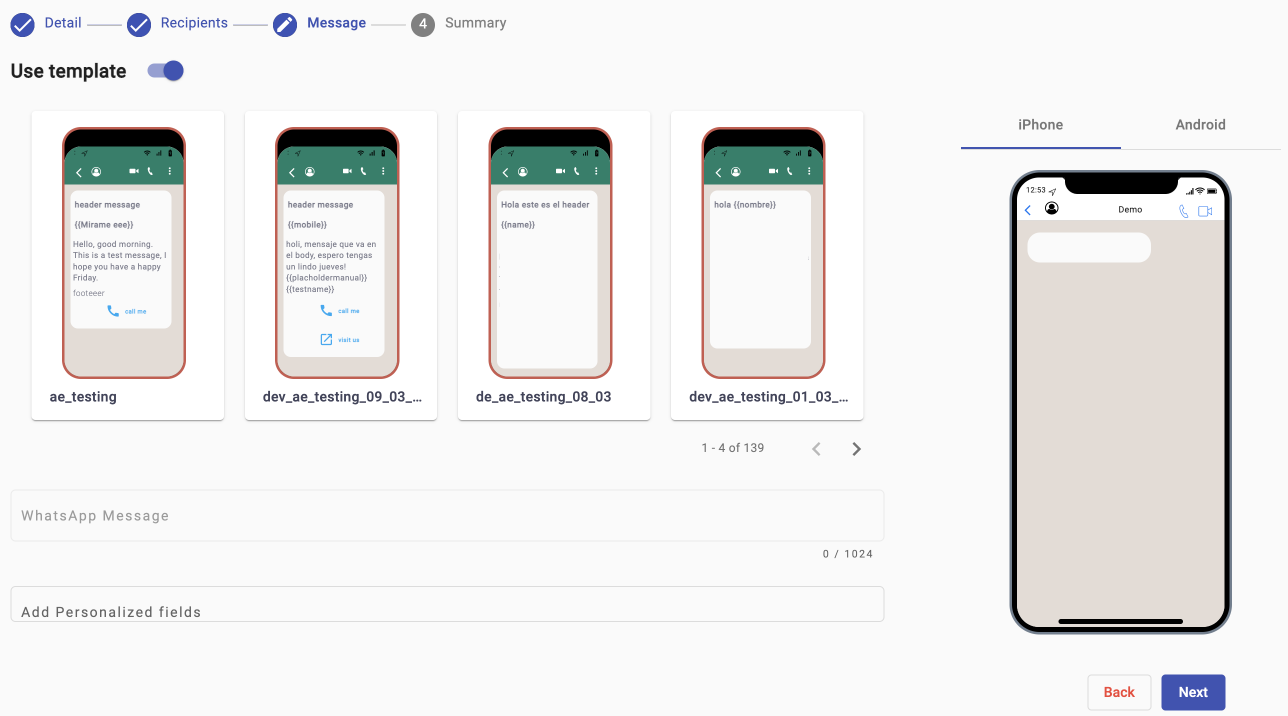
The steps to send a message for this scenario are:
- Select the template to be used. The WhatsApp Message box will be filled with the template’s content and the emulated device will show a preview.
- If the WhatsApp Template chosen includes a Header with a media file, upload the required media file (image, video, document) in the template. (Editable for multimedia content, such as images, videos, or documents)\
NOTEWhen preparing to test or send an approved WhatsApp template with a header that includes a multimedia file, you must upload a media file (image, video, or document) as part of the process. Initially, when choose the template at the top displays the original media file configured when the template was created, allowing the user to review what was initially set.
For testing or actual message sending, META requests to re-upload the media file. This upload can be either the original file or a different file, depending on the user’s preference. This ensures that the correct media file accompanies each message sent, whether it’s a test message or a live message.
It is recommended that users read these policies to ensure that all content used in WhatsApp templates adheres to platform guidelines. Understanding these rules can help avoid rejections and ensure that images, videos, and other media align with WhatsApp’s standards for acceptable, respectful, and compliant content. Understanding these rules can help avoid rejections and ensure that images, videos, and other media align with WhatsApp’s standards for acceptable, respectful, and compliant content.
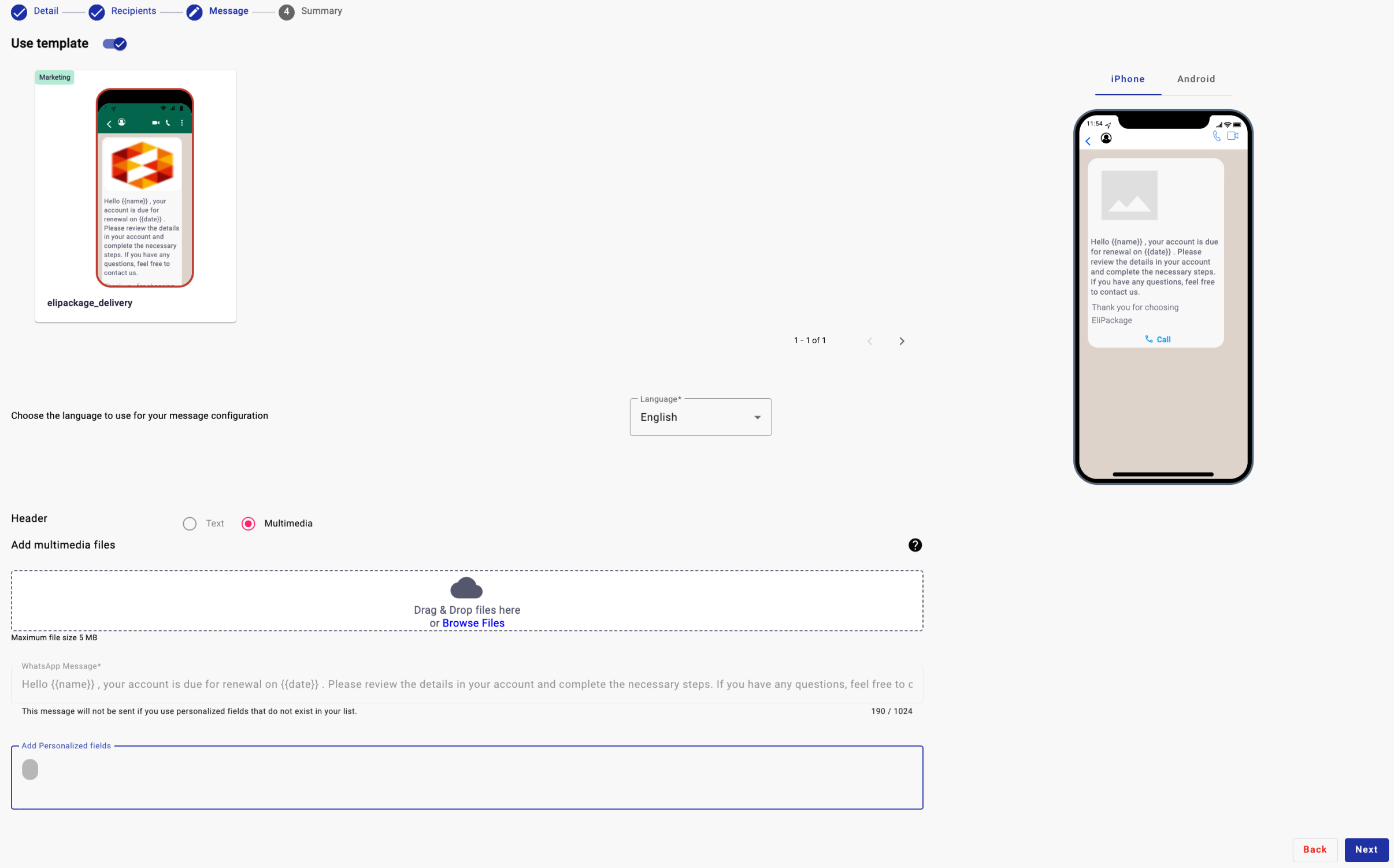
Depending on the template selected for the WhatsApp message, make sure that among the attributes associated to the subscriber, the values of the fields used in the template are included. For example, if the dev_ae_testing_09_03_2 template, shown in the graphic, is to be used in the message, the attributes associated with the subscriber must include the values of the [[mobile]], [[placholdermanual]], and [[testname]] fields.
- Select Next
ON SENDING MESSAGESMessages are sent only if all the information associated with the personalized fields in the template are present, otherwise the message will not be sent.
Without a Template
If your business has already engaged in communications with the customer(s) you intend to send campaigns or messages to, or the customer has contacted your business within a 24-hour window, you can by-bypass the template requirement by disabling the Use Template setting at the top of the screen.
ON ACCEPTABLE MESSAGES (24-hour window)WhatsApp's statement on acceptable messages:
“If a person initiates a chat with you, you may continue that conversation via WhatsApp for up to 24 hours after the last message sent to you by that person without charge ("24-hour Window")."
Messages outside the 24-hour window, will not be sent and will result in a FAILED state. We encourage you to review WhatsApp's policy here.
There are two type whatsApp message responses:
- Text
- Multimedia
Text
In this scenario you can create a text message of up to 4096 characters in length with personalized content with any of the platform fields, with or without emoji, and adding tracked URLs to the message.
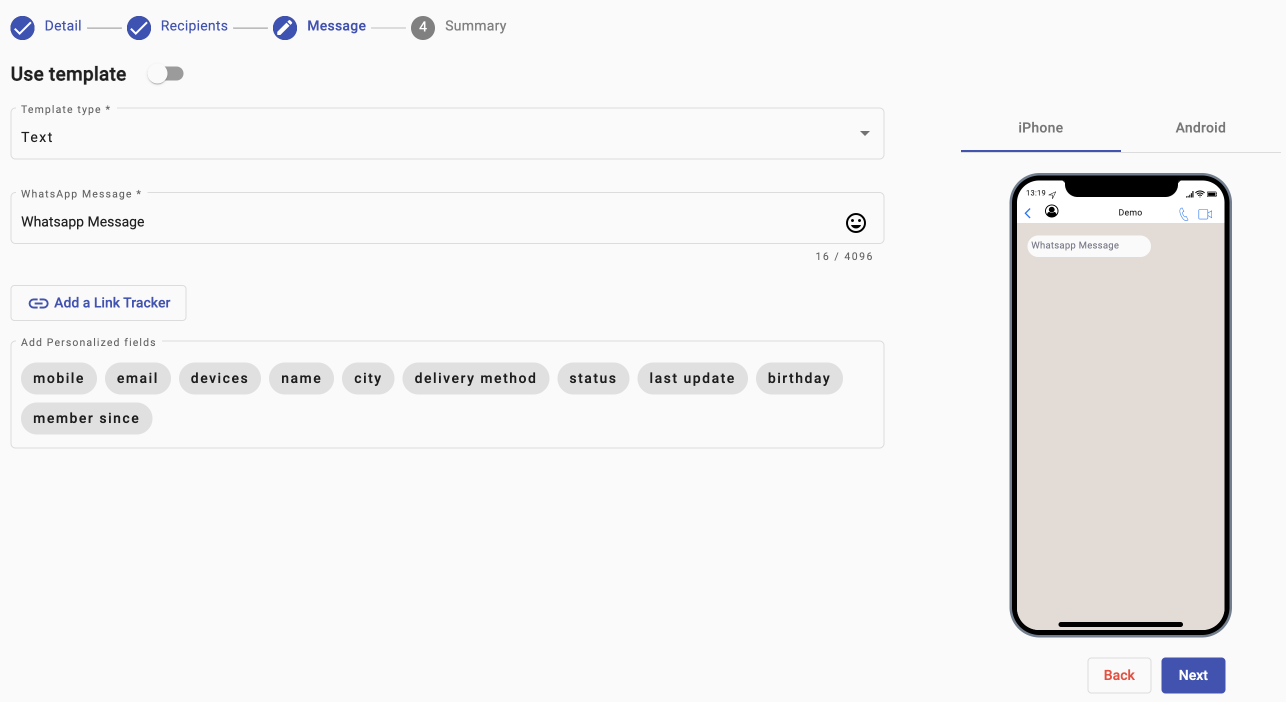
Multimedia
In this scenario you can create elaborate responses that include a text message of up to 4096 characters in length with personalized content, with or without emojis, include attachments of various file types, multimedia, pdf, up to 5 MB in size, and a Link tracker.
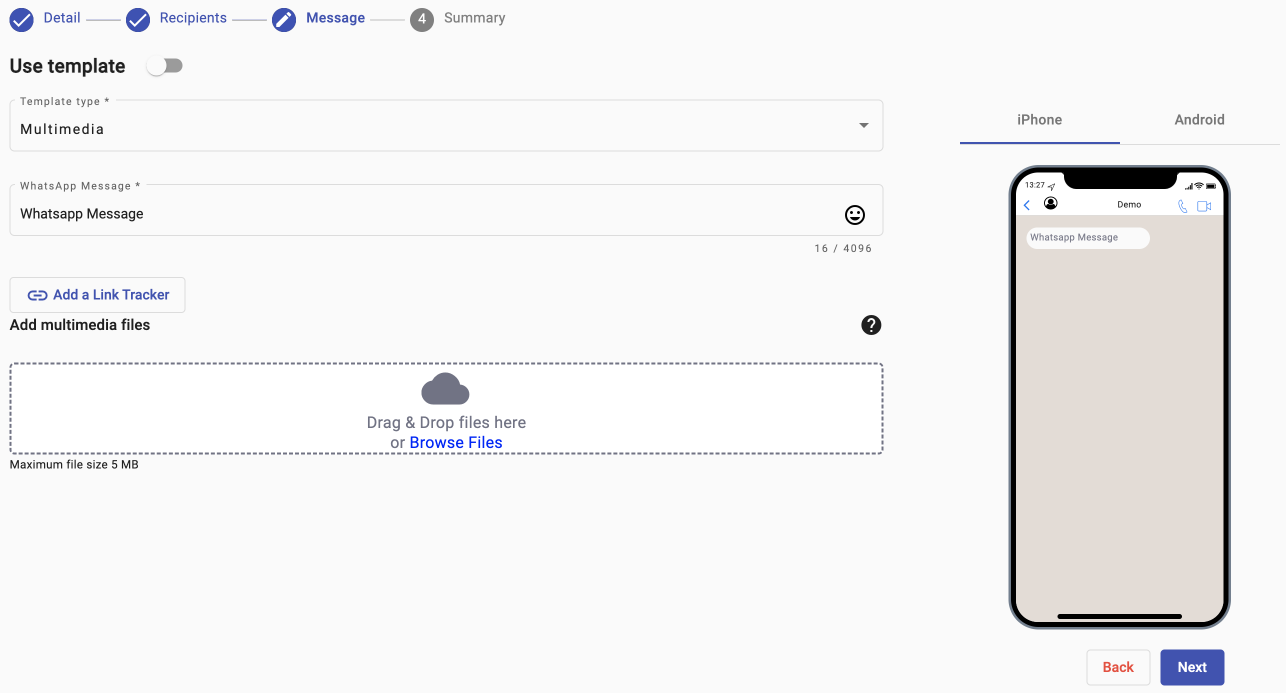
The steps to send a message for this scenario are:
-
Fill-out the WhatsApp Message box which can include emojis.
-
Optionally add one or more tracked URLs to the message.
-
Optionally include any attachments in the Add multimedia files box that does not exceed 5MB is size.
The details below specify the types of multimedia files that supports the platform, along with their maximum file sizes and supported formats:
-
Image: Images must be less than 5MB and the format must be .jpg or ..png
-
Video: Video must be less than 5MB and the format must be .mp4, .3gpp (Only H.264 video codec and AAC audio codec are supported).
-
Document: Documents must be less than 5MB and the format must be .pdf
-
Audio: Audio files must be less than 5MB and the format must be .mp4, .3gpp (Only H.264 video codec and AAC audio codec is supported).\
NOTEIt is recommended that users read these policies to ensure that all content used in WhatsApp templates adheres to platform guidelines. Understanding these rules can help avoid rejections and ensure that images, videos, and other media align with WhatsApp’s standards for acceptable, respectful, and compliant content.
-
-
Once completed the message content, select Next
Summary
In Summary, the final step of the WhatsApp campaign creator, is where you can
- Review campaign details.
- View configured link tracking settings.
- Set the message delivery Throttle configuration.
- Set the delivery timetable.
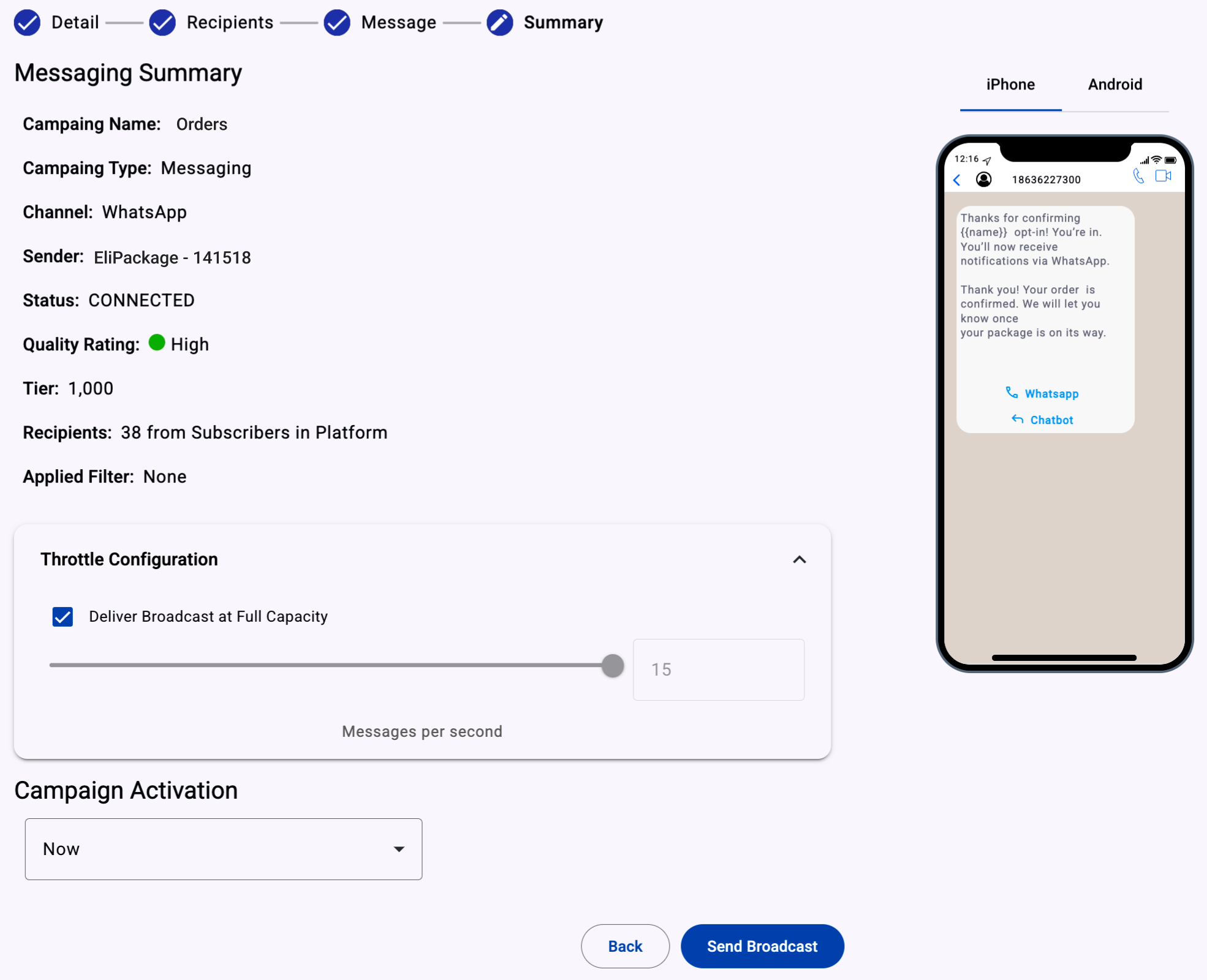
The Messaging Overview offers a quick way to double-check the Sender WhatsApp Business Account, the number of recipients, whether filters are applied or not, and the message contents in the emulated device screen.
For more information about the Summary step settings, go to Summary in the Campaign Elements section.
When you send WhatsApp messages, you can view the data and analytics (Report) of each message sent by going to the WhatsApp Reports section.
Edit WhatsApp Campaign
To be able to edit the WhatsApp campaign, the notification must not be sent yet. That is, once the user has completed each step, and the campaign activation has been saved as "Draft" or "Schedule", you will be able to edit each step of the campaign.
The steps to edit a WhatsApp campaign are the following:
Click on the Reports icon and select the Messaging tab. Then, locate the campaign saved as Pending (Draft) or Scheduled status and click on the Report button.
From the campaign car,d click on the Edit button. Once clicked, it will redirect you to the last step of the campaign configuration.
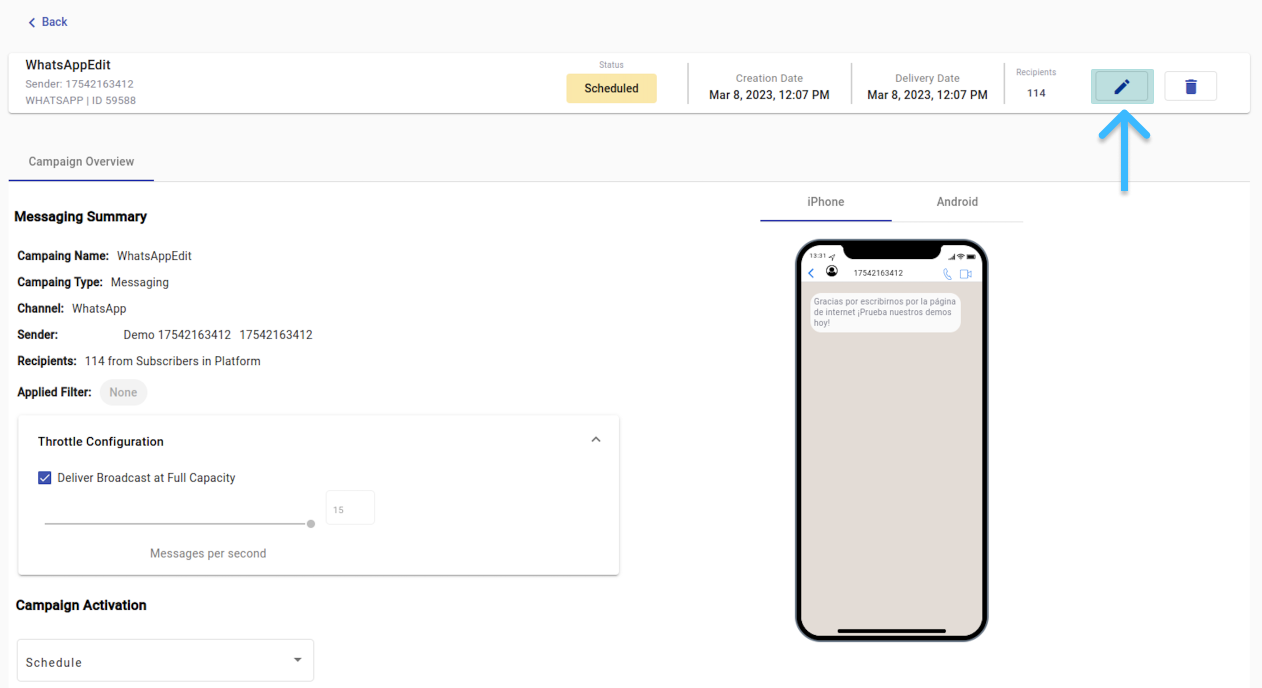
You can edit the:
- Sender WhatsApp Business Account.
- Recipients who will receive the message.
- Template (WhatsApp message).
- Throttle configuration.
- Campaign activation.
Once finished with the edition, select the Campaign Activation button located in the Summary section.
Updated 3 months ago
